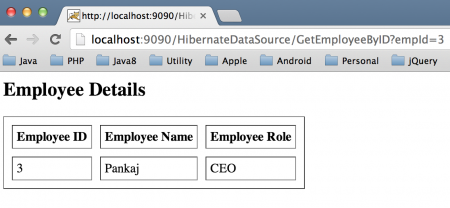Hibernate Tomcat JNDI DataSourceの例のチュートリアルへようこそ。すでにHibernate ORMツールをスタンドアロンのJavaアプリケーションで使用する方法を見てきましたが、今日はTomcatサーブレットコンテナでのデータソースとHibernateの使用方法を学びます。WebアプリケーションでHibernateを使用するのは非常に簡単で、必要なのはHibernate設定ファイルでDataSourceのプロパティを設定するだけです。まず、テストデータベースとTomcatコンテナ内のJNDIデータソースをセットアップする必要があります。
HibernateデータソースJNDIの例:データベースのセットアップ
I am using MySQL for my example, below script is executed to create a simple table and insert some values into it. employee.sql
CREATE TABLE `Employee` (
`id` int(11) unsigned NOT NULL AUTO_INCREMENT,
`name` varchar(20) DEFAULT NULL,
`role` varchar(20) DEFAULT NULL,
`insert_time` datetime DEFAULT NULL,
PRIMARY KEY (`id`)
) ENGINE=InnoDB AUTO_INCREMENT=26 DEFAULT CHARSET=utf8;
INSERT INTO `Employee` (`id`, `name`, `role`, `insert_time`)
VALUES
(3, 'Pankaj', 'CEO', now());
INSERT INTO `Employee` (`id`, `name`, `role`, `insert_time`)
VALUES
(14, 'David', 'Developer', now());
データベーススキーマ名はTestDBです。
Tomcat JNDIデータソースの設定
DataSourceを初期化するためにTomcatコンテナを設定するには、server.xmlとcontext.xmlファイルにいくつかの変更を加える必要があります。server.xml
<Resource name="jdbc/MyLocalDB"
global="jdbc/MyLocalDB"
auth="Container"
type="javax.sql.DataSource"
driverClassName="com.mysql.jdbc.Driver"
url="jdbc:mysql://localhost:3306/TestDB"
username="pankaj"
password="pankaj123"
maxActive="100"
maxIdle="20"
minIdle="5"
maxWait="10000"/>
上記のリソースをGlobalNamingResources要素に追加します。context.xml
<ResourceLink name="jdbc/MyLocalDB"
global="jdbc/MyLocalDB"
auth="Container"
type="javax.sql.DataSource" />
ResourceLinkをcontext.xmlファイルに追加してください。これは、アプリケーションがjdbc/MyLocalDBという名前のJNDIリソースにアクセスできるようにするために必要です。サーバーを再起動するだけで、tomcatサーバーのログにエラーが表示されません。パスワードが間違っているなどの誤った設定がある場合、対応する例外がサーバーログに表示されます。また、MySQLのドライバーjarファイルがtomcatのlibディレクトリ内にあることも確認する必要があります。そうでないと、tomcatはデータベース接続を作成できず、ログにClassNotFoundExceptionが表示されます。これで、データベースとtomcatサーバーのJNDIの設定が完了しました。次に、Hibernateを使用してウェブアプリケーションを作成しましょう。
Hibernateのデータソースの例 ダイナミックウェブプロジェクト
Eclipseで動的なWebプロジェクトを作成し、それをMavenプロジェクトとして設定します。最終的なプロジェクトの構造は以下の画像のようになります。  なお、プロジェクトの展開には
なお、プロジェクトの展開には
Hibernate Mavenの依存関係
最終的なpom.xmlファイルは以下のようになります。
<project xmlns="https://maven.apache.org/POM/4.0.0" xmlns:xsi="https://www.w3.org/2001/XMLSchema-instance"
xsi:schemaLocation="https://maven.apache.org/POM/4.0.0 https://maven.apache.org/xsd/maven-4.0.0.xsd">
<modelVersion>4.0.0</modelVersion>
<groupId>HibernateDataSource</groupId>
<artifactId>HibernateDataSource</artifactId>
<version>0.0.1-SNAPSHOT</version>
<packaging>war</packaging>
<dependencies>
<dependency>
<groupId>org.hibernate</groupId>
<artifactId>hibernate-core</artifactId>
<version>4.3.5.Final</version>
</dependency>
<dependency>
<groupId>mysql</groupId>
<artifactId>mysql-connector-java</artifactId>
<version>5.0.5</version>
<scope>provided</scope>
</dependency>
</dependencies>
<build>
<plugins>
<plugin>
<artifactId>maven-war-plugin</artifactId>
<version>2.3</version>
<configuration>
<warSourceDirectory>WebContent</warSourceDirectory>
<failOnMissingWebXml>false</failOnMissingWebXml>
</configuration>
</plugin>
<plugin>
<artifactId>maven-compiler-plugin</artifactId>
<version>3.1</version>
<configuration>
<source>1.7</source>
<target>1.7</target>
</configuration>
</plugin>
</plugins>
<finalName>${project.artifactId}</finalName>
</build>
</project>
I am using Hibernate latest version 4.3.5.Final, hibernate-core dependency is added for Hibernate. mysql-connector-java dependency is added because we are using MySQL database, although scope is provided because it’s already part of the tomcat container libraries. Even if we don’t add MySQL driver dependencies, our project will compile and run fine. However it’s better to include it so that if someone will look into the project dependencies, it will be clear that we are using MySQL database.
Hibernateデータソースの設定
データソースを含むHibernateの設定ファイルは以下のようになります。hibernate.cfg.xml
<?xml version="1.0" encoding="UTF-8"?>
<!DOCTYPE hibernate-configuration PUBLIC
"-//Hibernate/Hibernate Configuration DTD 3.0//EN"
"https://hibernate.org/dtd/hibernate-configuration-3.0.dtd">
<hibernate-configuration>
<session-factory>
<property name="hibernate.connection.driver_class">com.mysql.jdbc.Driver</property>
<property name="hibernate.dialect">org.hibernate.dialect.MySQLDialect</property>
<property name="hibernate.connection.datasource">java:comp/env/jdbc/MyLocalDB</property>
<property name="hibernate.current_session_context_class">thread</property>
<!-- Mapping with model class containing annotations -->
<mapping class="com.journaldev.servlet.hibernate.model.Employee"/>
</session-factory>
</hibernate-configuration>
hibernate.connection.datasourceプロパティは、Hibernateがデータベース操作に使用するDataSourceの名前を提供するために使用されます。
HibernateのDataSourceの例のモデルクラス
hibernateの設定ファイルで見ることができるように、私たちはモデルクラスEmployeeでアノテーションを使用しています。モデルビーンは以下のようになります。Employee.java
package com.journaldev.servlet.hibernate.model;
import java.util.Date;
import javax.persistence.Column;
import javax.persistence.Entity;
import javax.persistence.GeneratedValue;
import javax.persistence.GenerationType;
import javax.persistence.Id;
import javax.persistence.Table;
import javax.persistence.UniqueConstraint;
@Entity
@Table(name="Employee",
uniqueConstraints={@UniqueConstraint(columnNames={"ID"})})
public class Employee {
@Id
@GeneratedValue(strategy=GenerationType.IDENTITY)
@Column(name="ID", nullable=false, unique=true, length=11)
private int id;
@Column(name="NAME", length=20, nullable=true)
private String name;
@Column(name="ROLE", length=20, nullable=true)
private String role;
@Column(name="insert_time", nullable=true)
private Date insertTime;
public int getId() {
return id;
}
public void setId(int id) {
this.id = id;
}
public String getName() {
return name;
}
public void setName(String name) {
this.name = name;
}
public String getRole() {
return role;
}
public void setRole(String role) {
this.role = role;
}
public Date getInsertTime() {
return insertTime;
}
public void setInsertTime(Date insertTime) {
this.insertTime = insertTime;
}
}
モデルビーンはHibernate入門チュートリアルで使用したものと同じですので、アノテーションの使用に関して疑問がある場合は、ぜひ確認してください。
Hibernate DataSource Tomcat JNDI Servlet Listener
アプリケーション内でHibernateのSessionFactoryを初期化する必要があるため、ServletContextListenerの実装でこれを行うのが最適です。 HibernateSessionFactoryListener.java
package com.journaldev.servlet.hibernate.listener;
import javax.servlet.ServletContextEvent;
import javax.servlet.ServletContextListener;
import javax.servlet.annotation.WebListener;
import org.hibernate.SessionFactory;
import org.hibernate.boot.registry.StandardServiceRegistryBuilder;
import org.hibernate.cfg.Configuration;
import org.hibernate.service.ServiceRegistry;
import org.jboss.logging.Logger;
@WebListener
public class HibernateSessionFactoryListener implements ServletContextListener {
public final Logger logger = Logger.getLogger(HibernateSessionFactoryListener.class);
public void contextDestroyed(ServletContextEvent servletContextEvent) {
SessionFactory sessionFactory = (SessionFactory) servletContextEvent.getServletContext().getAttribute("SessionFactory");
if(sessionFactory != null && !sessionFactory.isClosed()){
logger.info("Closing sessionFactory");
sessionFactory.close();
}
logger.info("Released Hibernate sessionFactory resource");
}
public void contextInitialized(ServletContextEvent servletContextEvent) {
Configuration configuration = new Configuration();
configuration.configure("hibernate.cfg.xml");
logger.info("Hibernate Configuration created successfully");
ServiceRegistry serviceRegistry = new StandardServiceRegistryBuilder().applySettings(configuration.getProperties()).build();
logger.info("ServiceRegistry created successfully");
SessionFactory sessionFactory = configuration
.buildSessionFactory(serviceRegistry);
logger.info("SessionFactory created successfully");
servletContextEvent.getServletContext().setAttribute("SessionFactory", sessionFactory);
logger.info("Hibernate SessionFactory Configured successfully");
}
}
サーブレットリスナーについて詳しく知りたい場合は、「Servletリスナーのチュートリアル」を読んでください。
Hibernate Tomcat JNDIの例 Servletの実装
単純なサーブレットを作成しましょう。リクエストパラメータとして従業員IDを渡し、データベースから従業員情報を出力します。もちろん、データベースのクエリにはHibernateを使用します。GetEmployeeByID.java
package com.journaldev.servlet.hibernate;
import java.io.IOException;
import java.io.PrintWriter;
import javax.servlet.ServletException;
import javax.servlet.annotation.WebServlet;
import javax.servlet.http.HttpServlet;
import javax.servlet.http.HttpServletRequest;
import javax.servlet.http.HttpServletResponse;
import org.hibernate.Session;
import org.hibernate.SessionFactory;
import org.hibernate.Transaction;
import org.jboss.logging.Logger;
import com.journaldev.servlet.hibernate.model.Employee;
@WebServlet("/GetEmployeeByID")
public class GetEmployeeByID extends HttpServlet {
private static final long serialVersionUID = 1L;
public final Logger logger = Logger.getLogger(GetEmployeeByID.class);
protected void doGet(HttpServletRequest request, HttpServletResponse response) throws ServletException, IOException {
int empId = Integer.parseInt(request.getParameter("empId"));
logger.info("Request Param empId="+empId);
SessionFactory sessionFactory = (SessionFactory) request.getServletContext().getAttribute("SessionFactory");
Session session = sessionFactory.getCurrentSession();
Transaction tx = session.beginTransaction();
Employee emp = (Employee) session.get(Employee.class, empId);
tx.commit();
PrintWriter out = response.getWriter();
response.setContentType("text/html");
if(emp != null){
out.print("<html><body><h2>Employee Details</h2>");
out.print("<table border=\"1\" cellspacing=10 cellpadding=5>");
out.print("<th>Employee ID</th>");
out.print("<th>Employee Name</th>");
out.print("<th>Employee Role</th>");
out.print("<tr>");
out.print("<td>" + empId + "</td>");
out.print("<td>" + emp.getName() + "</td>");
out.print("<td>" + emp.getRole() + "</td>");
out.print("</tr>");
out.print("</table></body><br/>");
out.print("</html>");
}else{
out.print("<html><body><h2>No Employee Found with ID="+empId+"</h2></body></html>");
}
}
}
非常にシンプルなサーブレットクラスです。URIパターンを提供するために@WebServletアノテーションを使用しています。
Hibernate DataSource Tomcat JNDIの例アプリケーションをテストする
私たちのアプリケーションは準備ができました。warファイルとしてエクスポートし、Tomcatコンテナにデプロイしてください。以下は、アプリケーションのサーブレットを呼び出した際のいくつかのスクリーンショットです。
 注意:リクエストURLのクエリ文字列にempIdのリクエストパラメータを渡しています。サーバーログには、アプリケーションが生成したログも表示されます。
注意:リクエストURLのクエリ文字列にempIdのリクエストパラメータを渡しています。サーバーログには、アプリケーションが生成したログも表示されます。
May 08, 2014 8:14:16 PM org.hibernate.cfg.Configuration configure
INFO: HHH000043: Configuring from resource: hibernate.cfg.xml
May 08, 2014 8:14:16 PM org.hibernate.cfg.Configuration getConfigurationInputStream
INFO: HHH000040: Configuration resource: hibernate.cfg.xml
May 08, 2014 8:14:16 PM org.hibernate.cfg.Configuration doConfigure
INFO: HHH000041: Configured SessionFactory: null
May 08, 2014 8:14:16 PM com.journaldev.servlet.hibernate.listener.HibernateSessionFactoryListener contextInitialized
INFO: Hibernate Configuration created successfully
May 08, 2014 8:14:16 PM com.journaldev.servlet.hibernate.listener.HibernateSessionFactoryListener contextInitialized
INFO: ServiceRegistry created successfully
May 08, 2014 8:14:16 PM org.hibernate.dialect.Dialect <init>
INFO: HHH000400: Using dialect: org.hibernate.dialect.MySQLDialect
May 08, 2014 8:14:17 PM org.hibernate.engine.jdbc.internal.LobCreatorBuilder useContextualLobCreation
INFO: HHH000423: Disabling contextual LOB creation as JDBC driver reported JDBC version [3] less than 4
May 08, 2014 8:14:17 PM org.hibernate.engine.transaction.internal.TransactionFactoryInitiator initiateService
INFO: HHH000399: Using default transaction strategy (direct JDBC transactions)
May 08, 2014 8:14:17 PM org.hibernate.hql.internal.ast.ASTQueryTranslatorFactory <init>
INFO: HHH000397: Using ASTQueryTranslatorFactory
May 08, 2014 8:14:17 PM com.journaldev.servlet.hibernate.listener.HibernateSessionFactoryListener contextInitialized
INFO: SessionFactory created successfully
May 08, 2014 8:14:17 PM com.journaldev.servlet.hibernate.listener.HibernateSessionFactoryListener contextInitialized
INFO: Hibernate SessionFactory Configured successfully
May 08, 2014 8:14:32 PM com.journaldev.servlet.hibernate.GetEmployeeByID doGet
INFO: Request Param empId=3
May 08, 2014 8:15:22 PM com.journaldev.servlet.hibernate.GetEmployeeByID doGet
INFO: Request Param empId=3
アプリケーションをアンデプロイするかサーバーを停止すると、SessionFactoryの破棄に関するサーバーログが表示されます。
May 08, 2014 11:31:16 PM com.journaldev.servlet.hibernate.listener.HibernateSessionFactoryListener contextDestroyed
INFO: Closing sessionFactory
May 08, 2014 11:31:16 PM com.journaldev.servlet.hibernate.listener.HibernateSessionFactoryListener contextDestroyed
INFO: Released Hibernate sessionFactory resource
これがTomcatコンテナ向けのHibernateデータソースの例です。理解して実装するのが簡単であることを願っています。以下のリンクからサンプルプロジェクトをダウンロードして、もっと試してみてください。
Source:
https://www.digitalocean.com/community/tutorials/hibernate-tomcat-jndi-datasource-example-tutorial













